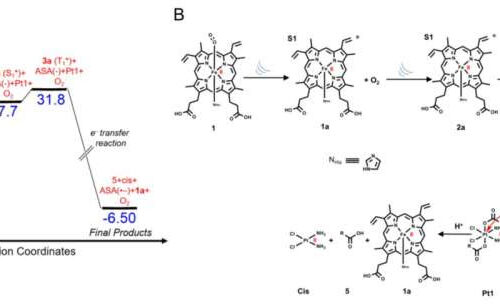by Meike Drießen, Ruhr-Universitaet-Bochum Proposed mechanism of the reduction of the PtIV prodrug Pt1 with the pentacoordinated sonosensitizer using DFT calculations. (A) Energy profile diagram of the reduction, indicative that the reaction is thermodynamically unfavored. (B) Proposed reduction mechanism . Credit: Angewandte Chemie International Edition (2023). DOI: 10.1002/anie.202301074 Chemotherapy treatments produce strong side effects. A new agent that accumulates...
Immunomodulators boost vaccine response and reduce inflammation, finds study
by Emily Ayshford, University of Chicago Graphical abstract. Credit: ACS Central Science (2023). DOI: 10.1021/acscentsci.2c01351 Adjuvants—ingredients that help boost the immune response in vaccines—have been used in vaccines for decades. But inducing a stronger immune response can result in more unwanted side effects, like swelling at the injection site or fever and body aches. Researchers at the...
Emory researchers discover key pathway for COVID organ damage in adults
EMORY HEALTH SCIENCES Even after three years since the emergence of COVID-19, much remains unknown about how it causes severe disease, including the widespread organ damage beyond just the lungs. Increasingly, scientists are learning that organ dysfunction results from damage to the blood vessels, but why the virus causes this damage is unclear. Now a...
Strength training shown to reduce blood pressure when practiced with moderate to vigorous intensity 2–3 times a week
by Ricardo Muniz, FAPESP (A) Funnel plot for the meta-analysis of strength training such as treatment of hypertension. Egger’s test (P = 0.01729) shows a significant publication bias. Beck et al. and Moraes et al. are the biggest outliers. (B) Risk of bias graph. Credit: Scientific Reports (2023). DOI: 10.1038/s41598-022-26583-3 Strength training practiced with moderate to vigorous intensity two...
Herbal compound blocks progression of rheumatoid arthritis by inhibiting protein
by Osaka University We all know that a strong immune system is a definite advantage. Yet, sometimes, the immune system goes awry and attacks the body. This autoimmunity is the cause of various disorders, such as rheumatoid arthritis, Crohn’s disease, type 1 diabetes, and celiac disease. To fight these diseases, it is crucial to determine...
Could a novel small molecule slow or reverse the effects of Duchenne muscular dystrophy?
by Wiley Histopathology of gastrocnemius muscle from patient who died of pseudohypertrophic muscular dystrophy, Duchenne type. Cross section of muscle shows extensive replacement of muscle fibers by adipose cells. Credit: Wikimedia Commons/Public Domain In a new study published in The FASEB Journal, investigators demonstrated the potential of a molecule that may help overcome some of the...
Can phototherapy improve cognitive function in patients with dementia?
by Wiley Credit: Pixabay/CC0 Public Domain In an analysis of published clinical trials, investigators found that phototherapy—or exposure to sessions of bright light—may be a promising non-pharmacological intervention for lessening symptoms of dementia. The analysis in Brain and Behavior included 12 randomized clinical trials. Results indicated that phototherapy improved cognitive function in patients with dementia, but it did...
Palliative care doesn’t improve psychological distress, finds study
by Deion Wright, Rutgers University Credit: Unsplash/CC0 Public Domain Palliative care—a specialized medical care focused on quality of life for people with a serious illness such as cancer or heart failure—isn’t likely to reduce psychological distress, according to a Rutgers study. Researchers involved with the study, published in the Journal of Pain and Symptom Management, found there...
Research links greater gestational vitamin D in blood with reduced childhood behavioral issues
by Amy Cherry, University of Delaware Credit: Jeffrey C. Chase/University of Delaware If you work indoors, live in the north, avoid the sun, are lactose intolerant, vegan, elderly or darker skinned, chances are you may be deficient in vitamin D. It’s a common problem affecting as many as 25% of Americans, according to a recent study. Deficiency...
Tool targets cancer-causing fusions’ weak spot
by St. Jude Children’s Research Hospital Model of fusion etiology and study design. a Theoretical mechanisms of oncogenic fusion formation. Scenario 1: the DNA breakpoints (red lines) can lead to the fusion of coding exons (thick boxes) from N’ gene to 5’ untranslated region (UTR; thin boxes) of C’ gene and result in the conversion of the...

